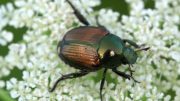|
Click to listen to this article
|
Potato fields usually harbor a lot of predator insects (like big-eyed bugs, damsel bugs, ladybird beetles, and more) that help to control aphid populations. Unfortunately, they may not be able to keep the aphids in check for the entire growing season, either because predator populations are reduced by broad-spectrum insecticides like pyrethroids, or other factors favor rapid aphid development that predators can’t match.
There are no established action thresholds for applying insecticides to control aphids in potato fields. Some growers act when populations rise to 1 aphid per plant, and others prefer to wait until there are 3 aphids per plant.
It is important to know that once aphid populations begin to buildup, they tend to increase exponentially and can become very large, very fast. Large populations may be difficult to control with a single insecticide application.
Washington State University Extension reported that the in week ending August 6, 2021, there was a big increase in aphid numbers across most of the Columbia Basin.
Aphids were collected in 98% of the fields they monitored, averaging about 0.8 aphids per plant, which is up from 0.3 per plant from the previous week. About 30% of the fields averaged more than one aphid per plant.
SOURCE: WSU Extension






